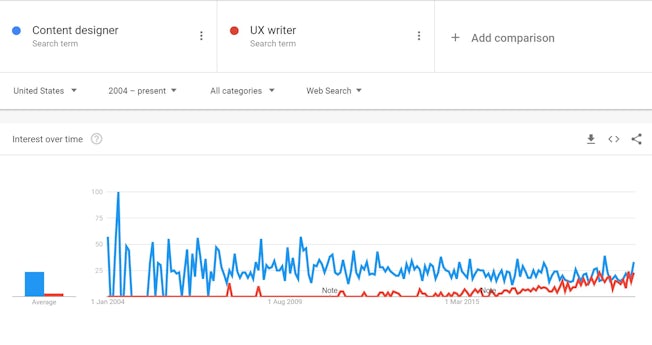The role of ‘UX writer’ has become increasingly sought-after as companies make user experience (UX) a focal point for their business. But what exactly does a UX writer do?
Over the past few years, there has been a dramatic uptick in awareness across the marketing and technology industries about the importance of user experience (UX).
Companies that do UX well have reaped considerable rewards, and businesses have increasingly prioritised creating a smooth, seamless user experience across their digital touchpoints.
With this rise in UX awareness has come a proliferation of specialist UX roles: UX designer, UX researcher, UX consultant, UX writer. Some of these are wholly new roles, while others are a new slant on a role that might have been around for some time.
In this article I’ll take a closer look at the role of UX writer, sometimes known as UX copywriter. What does the discipline of UX writing involve, and how does it differ from copywriting or content writing? And is it the same thing as a content designer?
What is a UX writer?
UX writers are responsible for crafting the text that appears throughout a website, app or other digital product interface. This includes everything from error pages (404s, 401s, 502s, etc.) confirmation messages and help pop-ups to buttons, menus, and sign-up forms. These little bits of text that appear throughout a product are often referred to as ‘microcopy’.
UX writers have a responsibility to guide a user through using the product in an intuitive manner. This means that they need to have a deep understanding of the product and its design and development process as well as of the product’s user base. UX writers are often called upon to conduct user testing and interpret data and analytics in order to understand how the product is used and how effectively the copy is performing.
However, a UX writer isn’t someone who simply comes in after a product is already designed and fills in the blanks with text. Instead, UX writers are instrumental in shaping the experience of a product. They are embedded within design teams, working hand-in-hand with UX and UI designers, UX researchers and information architects to ensure that product layout and copy work seamlessly together.
UX writers also need to make sure that the copy is achieving business objectives while keeping the user and their needs front of mind.
How does UX writing differ from copywriting or editorial?
UX writing is sometimes confused for copywriting (particularly as the role is sometimes referred to as a ‘UX copywriter’). However, while many UX writers have a background in writing marketing copy, the difference is in the objective: copywriting is designed to market to the user. It is inherently persuasive, aimed at attracting new users, engaging them, and convincing them to upgrade, spend more, or make a purchase.
Marketing copy often sets out to nudge the user down a path they might not originally have been on, whereas UX writing is there to smoothly guide the user towards their intended goal and facilitate their experience of using the product.
Copywriters and UX writers do have one key thing in common: brand tone. Just as copywriters need to be able to craft copy that uses a brand’s distinctive tone, so too do UX writers need to be able to convey the brand’s voice across all touchpoints and in a consistent fashion.
Similarly, UX writers are not responsible for writing content marketing or editorial, though they may have an editorial background and call upon similar skills. With that said, a UX writer might be called upon to help other content creators in the organisation to understand and communicate the brand’s tone, or tasked with creating a company-wide content style guide that is referenced by content writers across the organisation.
What skills should a UX writer have?
UX writing calls upon a mixture of skills across writing, communication, psychology and design. While there’s no requirement to have a formal background in anything specific (as UX writing is a relatively new specialism, there is no set route into the role and UX writers tend to come from a range of professional backgrounds), these are the skills most relevant to a role in UX writing:
- Strong writing and communication skills; the ability to write clearly and concisely
- Creative problem-solving skills
- An understanding of product design and how to improve it
- Research and analytical skills; the ability to understand and interpret data
- Strong teamwork and collaborative capability
- Attention to detail
- Empathy, and a passion for improving the user experience
UX writing and content design: What’s the difference?
You might have come across the role of ‘content designer’ and thought that the description sounded very similar to a UX writer, or heard them referred to as disciplines that are often conflated or confused. So, what is the difference between a UX writer and a content designer?
‘Content designer’ is a term that vastly predates ‘UX writer’, which has only recently (in the last three years or so) started to enjoy widespread usage. A Google Trends comparison of the two terms will show you that ‘Content designer’ dates back at least as far as 2004 (no Trends data exists prior to this point), while ‘UX writer’ is just creeping up to the same level of usage and beginning to overtake it as the preferred term.

A Google Trends comparison over time of the search terms ‘Content designer’ and ‘UX writer’, using US search data.
Broadly speaking, ‘content designer’ and ‘UX writer’ are two different names for the same role. UX writing is sometimes thought to refer more narrowly to writing microcopy and nothing else, but as I’ve covered above, UX writers are frequently expected to play a role in the product design process, advocate for the user, conduct research and testing, and set down style guidelines for wider content production.
Content design is also sometimes understood to refer to the design of all types of content – including things like graphics, animation, video and audio – but it most frequently crops up in the context of written content.
Many die-hard advocates of content design will insist that this term is the most accurate and useful, particularly as it speaks directly to the fact that the role is a design one. However, UX writing proponents will contend that having ‘UX’ in the title is most relevant and speaks to the role’s primary goal of facilitating a smooth user experience regardless of what that involves.
Ultimately, the title used to refer to a role will always depend on the company; some companies use the term ‘content strategist’ to mean a UX writer or content designer, while others will call the role a ‘digital content specialist’.
There might be an emphasis on slightly different skillsets depending on the job title, but the scope, responsibilities and expectations will always vary from organisation to organisation – so if you’re interested in the discipline of UX writing, make sure to read up on content design as well.







